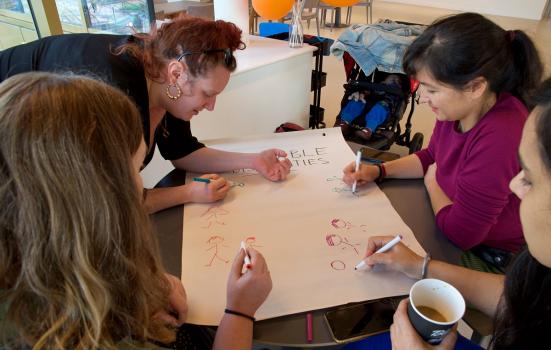Erica Ramsay, Geraldine Montgomerie and Holly Dannhauser explore the challenges faced by a local arts in health network – and how they mirror the hurdles for this work nationally.

The Leeds Arts, Health and Wellbeing Network (LAWHN), established in 2019, built on the city’s existing partnerships between arts, health, care and academia. However, it also recognised that Leeds had historically struggled to sustain these collaborations beyond short-term projects.
LAHWN seeks to create a forum for discussion and opportunities for sharing practice. Stakeholder organisations will work towards sustained collaborative capacity, while securing top level strategic support.
A promising start
Following the launch of the 2017 Creative Health report, the Leeds Health and Wellbeing board – a group of local councillors and the most senior representatives from health, care and voluntary sectors – supported proposals to establish our network, aligning the idea with Leeds’ ambition to be the best city for health and wellbeing. £20,000 was granted for a part-time project officer who could set up a working model. In May 2020, a second request was made for £25,000 in hope of eliciting match funding from Leeds City Council Adults and Health Directorate, Leeds Community Healthcare NHS Trust, Leeds Teaching Hospitals NHS Trust, Leeds Partnership Foundation Trust and the Leeds GP Confederation. The unanimous support we received amid the first peak of the pandemic is testament to Leeds’ commitment to arts in health work.
A governance group was established, with key partners from health and care represented, as well as a cross-section of the cultural sector. We have higher education institutions as well as organisations working specifically in arts and health, and freelance artists. We have improved the group’s efficiency and agency, adding a smaller management group to develop our vision and an accompanying business plan.
Our first year of operation has highlighted three issues that we will continue to battle with. To some extent, these reflect the challenges of cross-sector collaboration. These are: engagement and representation; demonstrating impact; and sustainability.
Engagement and representation
Most of LAHWN’s governance is made up of cultural sector representatives, along with a small number of dedicated health and care professionals. However, it is the health and care sector that has invested financially. This makes for an inequitable, and sometimes uncomfortable and uncertain, relationship between the sectors. While further work is needed to understand and strengthen participation, the complexity and scale of the health and care sector, coupled with existing and pandemic-related pressures on staff, do provide some context for the situation. Rather than overcoming a lack of interest, we need to create spaces for participants to understand each other’s worlds. In finding common ground and identifying what’s possible, we can grow their energy and willingness to collaborate.
Pre-Covid we began discussing the idea of a Creative Health Exchange where professionals from health and arts could learn about each other’s working contexts in a more structured way. During the pandemic, LAHWN and the Centre for Cultural Value, were partners on a Cultural Institute-led programme ‘Beyond Measure: Research and Evidence in Culture and Health'. This included a creativity on prescription project, facilitated by Leeds-based ‘Art Doctors’. Loosely based on social prescribing, a small cohort of health and care professionals and trainees volunteered to engage in creative activity, reflecting on its impact on them as individuals and as professionals.
Demonstrating impact
When we talk to different stakeholders and potential funders about the impact of our work, its value can be measured and expressed in a vast range of ways. LAHWN has facilitated conversation in this space. We partnered on the Beyond Measure programme and held a members’ event at Leeds Playhouse in 2019 that explored research, evidence and policy in this area. Cultural sector practitioners are often encouraged to use the same measures of impact used in health, but these can be an awkward fit. The Art Doctors tried using a common social prescribing tool in their creativity on prescription project; they ended up abandoning it as it wasn’t fit for purpose.
Many of the indicators used by health and care partners seek to improve measures of ill health, which can sometimes take years to shift. During the pandemic, simply mitigating harm to wellbeing and stopping the health of our most at-risk communities from declining may be a more realistic target. But how can this be effectively captured by stakeholders who are trying to achieve these outcomes in non-traditional ways?
Work to explore the Social Progress Index could prove valuable for LAHWN. The UCL Covid Social Study into the psychological and social impact of the pandemic is considering participation in culture and arts activities as one factor contributing to participants’ wellbeing. We feel optimistic about these developments in research and evidence – and their potential for translation into policy.
Sustainable initiatives
The sustainability of LAHWN and arts and health work depend on embedded engagement and representation across both sectors. We must be able to lever more equitable relationships and agree measures of impact. This is a long game; it’s about culture and policy change and shifting the balance of power. Furlough, job losses, and organisational fragility in both sectors have brought these challenges sharply into focus.
We’ve seen a lot of grassroots activity by health, care, voluntary and cultural organisations supporting communities during the pandemic. With health and care investment into community building approaches, this trajectory appears set to continue. West Yorkshire is due to elect a regional mayor in May, leading to speculation about how devolution may affect arts and health work. LAHWN is supporting the recognition of local skills and knowledge; a recent partnership with 100% Digital Leeds on webinars to help local practitioners innovate online is just one example.
Like others in arts and health, we continue to work with compassion and dedication. While we advocate the value of LAWHN and championing its work, we can’t take our eyes off the very real challenges ahead. Leeds is very much open for arts and health business. We want – and need – for it to stay that way.
Erica Ramsay is Project Manager of the Cultural Institute at the University of Leeds.
Geraldine Montgomerie is Project Officer at LAHWN.
Holly Dannhauser is Partnerships Development Manager at Leeds Health Partnerships.
![]() e.ramsay@leeds.ac.uk | g.montgomerie@leeds.ac.uk | holly.dannhauser@leeds.gov.uk
e.ramsay@leeds.ac.uk | g.montgomerie@leeds.ac.uk | holly.dannhauser@leeds.gov.uk
![]() lahwn.co.uk
lahwn.co.uk
![]() @leedsahwn
@leedsahwn




